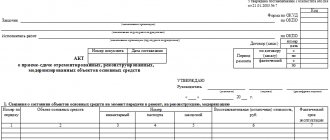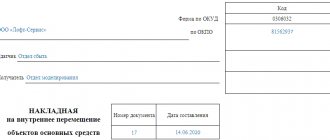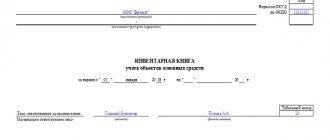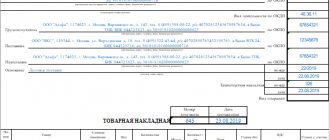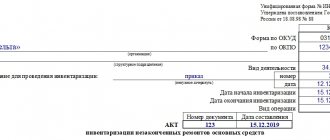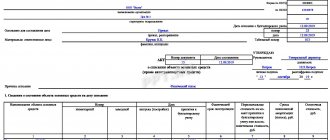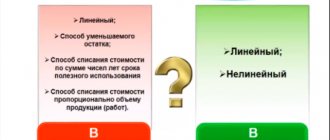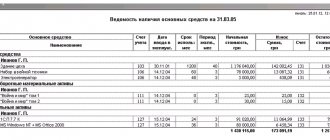The invoice for the internal movement of fixed assets, form OS-2, is intended to document the actual movement of any fixed assets of the organization. This can be interaction between workshops, sections, departments. The main thing is that both sides of the process (receiving and receiving units) belong to the same company.
- Form and sample
- Free download
- Online viewing
- Expert tested
FILES
The fixed assets of an organization may include buildings, various equipment, machines, instruments, computer equipment, inventory, various tools, livestock, etc. All this may well be transferred from one workshop or site to another.
If the useful life of different parts of one building is different, then it is worth dividing it into two independent objects and describing it separately.
Form OS-2. Invoice for internal movement of fixed assets
When transferring property related to fixed assets within one organization, for example, from one division to another, it is necessary to fill out an invoice for the internal movement of fixed assets in the OS-2 form.
To obtain a completed completed OS-2, as well as a blank version, follow the link at the end of the page.
It is necessary to draw up a separate invoice form OS-2 for each fixed asset item that is moved within the departments and structural units of one organization. The employee who is directly involved in the transfer of an object to another department is responsible for completing the OS-2 form.
The invoice form OS-2 must be filled out in triplicate. The first copy is signed by the party who accepts the property. It is intended for the financially responsible person who made the transfer. The representative of the party that accepts the fixed asset also receives its own version of the invoice in the OS-2 form with verification from the transferring party. The employee who will enter the necessary information for the OS-6 inventory card must take the third copy of the invoice, with the signatures of both parties, to the accounting department.
Reasons for transferring an object within an organization
The decision on the need for internal movement of fixed assets within one owner can only be made by the management of the enterprise.
Important! Funds can move between structural divisions, workshops, areas, etc.
In turn, the management of the department into which the funds fall has the right to distribute them within the association.
The following circumstances can be considered the main reasons for the internal movement of operating systems:
- the need for repairs, reconstruction or modernization;
- the need to transfer fixed assets to a subsidiary (branch), for which a separate balance sheet is allocated;
- the need to transfer OS objects to another department.
Form OS-2. Filling out an invoice for internal movement of fixed assets
| ★ Best-selling book “Accounting from scratch” for dummies (understand how to do accounting in 72 hours) > 8,000 books purchased |
Both sides of the OS-2 form must be filled out. The front side of the OS-2 form must contain the full name of the organization that owns the fixed asset; the structural units and their full names that take part in the transfer are immediately indicated.
On the OS-2 invoice form, the date of the transfer is indicated and it receives a serial number.
The name of the fixed asset item that is subject to movement between departments is indicated in the table. They immediately enter data regarding the date when it was purchased (produced or built), the number of such objects, as well as their price. Below, below the table, general information about the status of the fixed asset or assets involved in the transfer process is briefly listed.
When the invoice form in form OS-2 is completely filled out, representatives of both parties sign it. The representative of each party enters information about the position held, personnel number, full name, signature, date. After the accountant makes a mark on the inventory card, he signs the invoice at the bottom of the form.
Filling algorithm
The invoice is filled out on both sides. It consists of a header on the title side, a table of seven columns that continues on the reverse side, as well as a place for a brief description of the transferred object and signatures of the responsible persons.
In the upper right corner of the title part of the document there is a link to the Decree of the State Statistics Committee of 2003, which approved this form as mandatory. After 10 years, it became a recommendation, but its use continues.
At the top of the invoice, the OKUD and OKPO forms and the name of the company within which the movement takes place are indicated. The unit from which the object is being withdrawn is indicated first (it is called the “delivery”). The recipient department is indicated below.
Attention! The invoice must be filled out by the delivery department.
After the names of the departments, the name of the document, the date of preparation of the paper and the assigned number are written.
Below is a table with:
- number;
- a description that includes the date of manufacture (or construction), full name, inventory number;
- number of transferred objects in pieces;
- cost;
- results.
After the table, space is left to describe the object, its technical and other characteristics. When filling out, these lines cannot be left blank.
You can mention the condition (good, excellent, satisfactory), existing defects (scuffs, chips, etc.), and describe the packaging. If warranty cards or instructions are included, these are also included.
At the end there should be signatures (deciphered) of the persons who made the delivery and acceptance. The fact that information about the movement was entered into the accounting book is confirmed by the chief accountant (or simply the accountant who carried out the data transfer).
Important! When putting signatures, mentioning the positions of persons is mandatory.
Control
If during the inspection it is discovered that the object is under the jurisdiction of one division, but is registered with another, then the organization will face administrative liability in the form of a fine.
If a violation is detected for the first time and it does not lead to an understatement of taxes, then the company can get off with a fine of 5 thousand rubles.
If during the audit it is discovered that there is no invoice for the movement of fixed assets, form OS-2, and this fact will underestimate the taxes due from the organization, then less than 15 thousand rubles. There is no penalty for such a violation. Moreover, an amount of 10% of the total tax not paid for this reason may be assigned (but this amount will still not be less than 15 thousand rubles).
Using the OS-2 form, an invoice is filled out for the internal movement of fixed assets - for example, from one division of the company to another. The unified form of the OS-2 form was approved by Decree of the State Statistics Committee of January 21, 2003 No. 7. You are not obliged to use only unified forms - since 2013, enterprises have the right to develop their own forms of documents. The main thing is that the documents you develop contain all the required details. If you decide to develop the form yourself, you can use the OS-2 form as a sample to fill out, shortening the form or vice versa, adding the necessary details to it.
Invoice for internal movement of fixed assets
In what case might you need to register the transfer of a fixed asset? For example, you decide to repair or reconstruct a fixed asset yourself and for this you need to move the object to another premises.
In this case, you will need to complete the following documents:
- draw up a report on the defects that were identified in fixed assets;
- the manager must issue an order to eliminate the detected malfunctions;
- To register the move, fill out an invoice for internal movement.
Some people mistakenly believe that the gratuitous transfer of a fixed asset can be issued with an invoice in the OS-2 form, but this is not so. In this case, the transfer of a fixed asset must be formalized by an act of acceptance and transfer of the object in the OS-1 form, an invoice in the OS-2 form is filled out by enterprises only for internal movement.
Information that a fixed asset item has been moved to another division of the organization must also be included in the documents that are filled out in the company to record the availability and movement of fixed assets. The role of such a document can be, for example, an inventory card for recording fixed assets according to the unified form No. OS-6, if we are talking about a group of objects - a card for group accounting of fixed assets (form No. OS-6a), an inventory book for accounting for fixed assets ( Form No. OS-6b).
Important application features
The transfer invoice is not a document confirming the gratuitous transfer. For the latter, there is the OS-1 form, which implies the untimely placement of an object of fixed assets in the jurisdiction of the receiving unit.
Important! Form OS-2 implies temporary movement. It may be associated with repair work, temporary operation, etc.
Unified form OS-2. Sample filling.
The invoice for internal movement OS-2 is filled out in 3 copies, one of which is kept by the person who completed the movement, the second is intended for the receiving party, and the third must be transferred to the accounting department.
In the header of the form on the front side of the invoice for internal movement, fill in the name of the organization, the deliverer and receiver of fixed assets, the form code according to OKUD, the code according to OKPO, the document number and the date of its preparation.
The main part of the OS-2 act consists of a table that contains 7 columns:
- OS number in order;
- OS object name;
- date of purchase;
- inventory number;
- number of objects;
- unit cost;
- cost of everything.
Below the table there are lines to characterize the technical condition of the object. Next come the signatures of the person handing over and receiving the object: position, signature and transcript of the signature, personnel number, date. The unified form OS-2 is signed by the chief accountant.
In order to quickly and without errors fill out the invoice according to form OS-2, download and study the sample filling:
invoice for internal movement:
How many copies will be required?
The invoice must be filled out in at least 3 identical copies. This is done so that one invoice remains with the accountant (or the employee performing his duties) for the generation of further reporting. The second paper must be kept by the employee responsible for it for a specific facility. And the third option must be provided to the receiving party as confirmation of the verified fact. Ideally, all 3 invoices have 3 signatures of employees who are financially responsible.
Why do you need the TORG-13 form?
This invoice is important for the enterprise, especially in the case when the movement process is carried out with the help of third-party forces transporting cargo from one structural unit to another.
The main purpose of the TORG-13 consignment note is to confirm the fact of departure of goods or containers from one place and their arrival in another place. A correctly drawn up and certified form allows you to carry out the write-off and capitalization procedure in accounting.
In addition, the invoice performs an additional function - it allows you to justify to the Federal Tax Service the costs of moving inventory or containers from one department to another, when additional forces are involved for this purpose - transport companies.
Costs can be caused by the process of loading, unloading, and transportation. To take these expenses into account when calculating income tax, you need a documentary justification, which will be the invoice for internal movement TORG-13.
Arbitration practice shows that an invoice, drawn up correctly and signed by representatives of the sender and recipient, can confirm the existence of expenses. Additionally, the invoice can be supported by such documents as an act of transport services provided, a transport expedition agreement, and a waybill.
Recommendations for filling out TORG-13
The standard invoice form for the internal movement of goods was put into effect by Resolution of the State Statistics Committee No. 132 of December 25, 1998. Since the beginning of 2013 organizations are not obliged to strictly use standard primary forms; companies have the right to choose a convenient type of accounting document themselves.
If the enterprise is not satisfied with the unified form, then its own form can be developed. For development, you can use a standard form, supplementing it with necessary information.
For example, in the unified TORG-13 form there are no fields for indicating the addresses of structural units, and this can be important in the process of transporting goods and containers between them. In this case, the invoice form for internal movement can be supplemented with such a field.
The TORG-13 consignment note should indicate the name of the legal entity within which the cargo is being moved. The code of the main activity of this enterprise is also entered. The invoice is assigned a personal unique number; numbers should not be repeated within the same reporting period. The day the document was issued is indicated next to the number.
The following is information about the parties involved and the corresponding accounts:
- The name of the structural unit sending the goods and the direction of its activity;
- The name of the structural unit receiving the materials and the type of its activity;
- The number of the accounting account where the goods are sent (if analytical accounting is maintained for this account, then the corresponding code is indicated).
The table contains data on those items of inventories that are subject to internal movement between financially responsible persons:
| Column number | Procedure for filling out the column |
| 1 | Name of the valuables being moved (goods, semi-finished products, raw materials, containers). The main characteristics of the MPZ are also given. |
How to register internal OS movement
After accepting the asset for accounting and filling out the appropriate fields of the acceptance certificate, an inventory card is drawn up (form OS-6 or OS-6a), which will reflect each movement of the asset: movement, receipt, modernization, repair, disposal, etc. With a small number of OS objects, it is possible to maintain not cards, but an inventory book (form OS-6b).
To move fixed assets between warehouses or departments, an invoice for internal movement in the OS-2 form is used. This form is drawn up in 3 copies: the 1st remains with the financially responsible person (MRO) of the sending unit; The 2nd is sent to the accounting department, which makes the appropriate notes on the inventory card; The 3rd is transferred to the MOL of the recipient unit.
To record the fact of repair, reconstruction or installation of an OS, it is necessary to fill out an act form in the OS-3 form. This document reflects all information about the costs incurred, the contractor and is signed by the commission and the head of the company. If the work was carried out by a third-party company, the form must be prepared in 2 copies, one of which must be endorsed by the contractor.
We formalize the disposal of fixed assets
The act of write-off of fixed assets in the form OS-4 (OS-4b - for group write-off) accompanies cases of write-off of fixed assets that are out of order and cannot be repaired.
This form must be drawn up in 2 copies, signed by the head and a specially convened commission. The 1st copy of the document is given to the accounting department, the 2nd remains with the MOL and serves as the basis for the delivery of inventory items remaining as a result of dismantling (disassembling) the OS to the warehouse.
In case of disposal of a vehicle, it is necessary to submit a document to the accounting department that will confirm deregistration with the traffic police. To register such a write-off of an asset, you should use a form in the OS-4a form.
In the case of the sale of an asset, just as in the case of a purchase, a transfer and acceptance certificate in the OS-1 form is used. This document must be signed by the commission and the head of the company. Each organization (receiving and transferring parties) has its own page for filling out OS credentials.
Important application features
The transfer invoice is not a document confirming the gratuitous transfer. For the latter, there is the OS-1 form, which implies the untimely placement of an object of fixed assets in the jurisdiction of the receiving unit.
Important! Form OS-2 implies temporary movement. It may be associated with repair work, temporary operation, etc.
Filling algorithm
The invoice is filled out on both sides.
Sample order for transfer of fixed assets for conservation
OS, to the warehouse.
In case of disposal of a vehicle, it is necessary to submit a document to the accounting department that will confirm deregistration with the traffic police. To register such a write-off of an asset, you should use a form in the OS-4a form.
In the case of the sale of an asset, just as in the case of a purchase, a transfer and acceptance certificate in the OS-1 form is used. This document must be signed by the commission and the head of the company.
Order on transfer of fixed assets sample
Such data is recorded in proportion to the organization’s share in the common property right, while on the first page in the “For reference” section information about the participants in shared ownership is entered, indicating their share in the common property right. If the cost of acquisition of an item of fixed assets was expressed in foreign currency, this section contains information about the name of the foreign currency, its amount at the exchange rate of the Central Bank of the Russian Federation on the date selected in accordance with the requirements in force in the accounting system.
Data on the acceptance and exclusion of an object from fixed assets are entered into the inventory card or book of accounting of fixed assets (forms No. OS-6, No. OS-6a, No. OS-6b).
Very often, fixed assets are moved within an organization from one structural unit to another.
If you have a form developed by your company for creating such documents, you can use its sample.
The following information is required to be reflected:
- date of registration;
- serial number;
- full company name;
- the reason why there was a need for internal movement of fixed assets;
- information about the inventory carried out;
- information about financially responsible persons;
- appointment of commission members.
At the end of the order there must be a signature of the chief manager of the enterprise or his deputy.
In addition, when transferring fixed assets to another financially responsible person, the latter draws up a special receipt.
It acts as agreement with the information obtained during the inventory.
Unlike Resolution 71a, which provides for the execution of an act of one form, regardless of the type of fixed assets, Resolution No. 7 provides for three types of this act:
- Form No. OS-1 - for fixed assets (except for buildings and structures);
- form No. OS-1a - for buildings and structures;
- Form No. OS-1b - for groups of fixed assets (except for buildings and structures).
The form of the Certificate of acceptance and transfer of fixed assets is fundamentally different from the form of the Certificate (invoice) of acceptance and transfer of fixed assets. The new act consists of three sections, the first of which is filled out on the basis of the data of the transferring party, which is of an informational nature for objects of fixed assets that were in operation (date of commissioning, actual service life, useful life, amount of accrued depreciation, residual value). Tax Code of the Russian Federation, and are confirmed:
- <if the work is performed and services are provided by third-party organizations - certificates of work performed (services provided);
- <if the work was completed on your own, you can draw up an accounting certificate, attaching invoices for the materials used in the dismantling (installation) of the OS, accrued salary statements, waybills, etc.
Input VAT on work performed by third parties is accepted for deduction on the date of completion of work on the basis of the invoice no. 1 item 2 art. 171, paragraph 1, art. 172 of the Tax Code of the Russian Federation. For the purposes of calculating income tax paid to the budgets of the constituent entities of the Russian Federation, it is important to ensure that the movement of fixed assets among separate divisions is correctly reflected in tax accounting.
number and date;
- document's name;
- basis for compilation;
- details of the basis document for the movement (order).
The main part of the invoice contains a table containing seven columns:
- No. of the fixed asset in order;
- name of property;
- date of purchase of the OS;
- inventory number;
- number of objects to be moved;
- unit cost;
- the full value of the property being moved.
Below the table there are lines about the technical condition of the OS and its brief description is written.
Here the actual condition and the possibility of using the fixed asset for its intended purpose must be indicated.
Next, the visas of the receiving and transmitting parties are affixed: signature, position, transcript, personnel number and date.
Previously, the Certificate (invoice) of acceptance and transfer of fixed assets was used for these purposes, i.e. the same document as for recording the receipt and disposal of fixed assets.
The invoice is issued by the transferring party (delivery) in triplicate, signed by the responsible persons of the structural divisions of the recipient and the deliveryr. The first copy is transferred to the accounting department, the second remains with the person responsible for the safety of the fixed asset, and the third is transferred to the recipient.
Availability and movement of fixed assets To record the presence and movement of fixed assets, as well as to record their movement within the organization, inventory cards and inventory books are used, which are filled out on the basis of acts of acceptance and transfer of fixed assets and accompanying documents (technical passports of manufacturers and etc.).
Attention
If the transfer of a fixed asset is related to the production activities of the organization, then take into account the costs of its movement when calculating income tax in the following order. When using the accrual method, reduce the tax base according to the rules established for certain types of costs incurred when moving a fixed asset (Article 272 of the Tax Code of the Russian Federation). For example: – the salary of employees who dismantle and install equipment is taken into account monthly (clause
4 tbsp. 272 Tax Code of the Russian Federation);
– transport services are taken into account on the date of provision (subclause 6, clause 1, article 254, clause 2, article 272 of the Tax Code of the Russian Federation).
With the cash method, reflect the costs of performing work to move fixed assets as they are completed and paid for (clause 3 of Art.
According to the procedure for applying unified forms of primary accounting documentation, approved by Resolution of the State Statistics Committee of Russia dated March 24, 1999 No. 20, an organization can, if necessary, enter additional details into the unified forms of primary accounting documentation approved by the State Statistics Committee of Russia. At the same time, all details of the unified forms of primary accounting documentation approved by the State Statistics Committee of Russia remain unchanged (including code, form number, document name). Removing individual details from unified forms is not allowed.
Changes made must be documented in the relevant organizational and administrative document of the organization.
According to the specified Procedure, the formats of the forms specified in the album of unified forms of primary accounting documentation are recommended and may be changed.
Some people mistakenly believe that the gratuitous transfer of a fixed asset can be issued with an invoice in the OS-2 form, but this is not so. In this case, the transfer of a fixed asset must be formalized by an act of acceptance and transfer of the object in the OS-1 form, an invoice in the OS-2 form is filled out by enterprises only for internal movement.
Information that a fixed asset item has been moved to another division of the organization must also be included in the documents that are filled out in the company to record the availability and movement of fixed assets. The role of such a document can be, for example, an inventory card for recording fixed assets according to the unified form No. OS-6, if we are talking about a group of objects - a card for group accounting of fixed assets (form No. OS-6a), an inventory book for accounting for fixed assets ( Form No. OS-6b).
Why do you need the TORG-13 form?
This invoice is important for the enterprise, especially in the case when the movement process is carried out with the help of third-party forces transporting cargo from one structural unit to another.
The main purpose of the TORG-13 consignment note is to confirm the fact of departure of goods or containers from one place and their arrival in another place. A correctly drawn up and certified form allows you to carry out the write-off and capitalization procedure in accounting.
In addition, the invoice performs an additional function - it allows you to justify to the Federal Tax Service the costs of moving inventory or containers from one department to another, when additional forces are involved for this purpose - transport companies.
Costs can be caused by the process of loading, unloading, and transportation. To take these expenses into account when calculating income tax, you need a documentary justification, which will be the invoice for internal movement TORG-13.
Arbitration practice shows that an invoice, drawn up correctly and signed by representatives of the sender and recipient, can confirm the existence of expenses. Additionally, the invoice can be supported by such documents as an act of transport services provided, a transport expedition agreement, and a waybill.
Recommendations for filling out TORG-13
The standard invoice form for the internal movement of goods was put into effect by Resolution of the State Statistics Committee No. 132 of December 25, 1998. Since the beginning of 2013 organizations are not obliged to strictly use standard primary forms; companies have the right to choose a convenient type of accounting document themselves.
If the enterprise is not satisfied with the unified form, then its own form can be developed. For development, you can use a standard form, supplementing it with necessary information.
For example, in the unified TORG-13 form there are no fields for indicating the addresses of structural units, and this can be important in the process of transporting goods and containers between them. In this case, the invoice form for internal movement can be supplemented with such a field.
The TORG-13 consignment note should indicate the name of the legal entity within which the cargo is being moved. The code of the main activity of this enterprise is also entered. The invoice is assigned a personal unique number; numbers should not be repeated within the same reporting period. The day the document was issued is indicated next to the number.
The following is information about the parties involved and the corresponding accounts:
- The name of the structural unit sending the goods and the direction of its activity;
- The name of the structural unit receiving the materials and the type of its activity;
- The number of the accounting account where the goods are sent (if analytical accounting is maintained for this account, then the corresponding code is indicated).
The table contains data on those items of inventories that are subject to internal movement between financially responsible persons:
| Column number | Procedure for filling out the column |
| 1 | Name of the valuables being moved (goods, semi-finished products, raw materials, containers). The main characteristics of the MPZ are also given. |
Errors in filling out the TORG-13 invoice
An invoice for internal movement is a primary accounting document that allows you to:
- The accountant must make an entry for writing off inventories from one structural unit and accepting them for accounting in another unit.
- Justify before the Federal Tax Service the legality of accepting transfer expenses to reduce taxable profit when calculating income tax.
That is, the TORG-13 form performs important functions, and therefore errors in filling out the invoice are not allowed. First of all, it is necessary to provide a clear list of the goods being moved; there should be no errors in indicating the names, quantities, and costs.
The date of the transaction for the transfer of valuables between MOLs must be indicated. An invoice that is not certified by the sending and receiving parties will not allow the document to fulfill its purpose. That is, the uncertified TORG-13 form will be compiled with an error.
The signatures confirm that the internal displacement operation has been completed. The representative of the receiving party needs to sign only after the actual quantity and documentary data have been compared. By signing the TORG-13 form, the recipient confirms that he has accepted the amount of valuables stated in the invoice.
It would be a mistake to fill out the TORG-13 invoice regarding the movement of goods to another legal entity or individual entrepreneur. This form is intended exclusively for internal movements, when the transferred inventories remain in the organization, only their location changes.
Is it possible to change graphs?
All this data is necessary for maintaining full-fledged accounting and warehouse records in the organization. Since 2013, this form has ceased to be mandatory. It became only advisory, in accordance with the law “On Accounting” dated 06.12.2011 No. 402-FZ.
At its own discretion, the organization has the right to refuse some columns of the primary document or add new ones. However, all these changes must be documented and have good reasons.
In short, the form is widely used today because it is convenient, illustrates the maximum amount of information and does not confuse regulatory authorities when conducting inspections and audits.
What is an Internal Move Invoice?
This is a document that records the movement of products or material assets within one legal entity; depending on the type of objects being moved, unified document forms TORG-13 or OS-2 are used.
This document is evidence of the movement of values within the enterprise between structural units, departments, workshops or responsible persons. Also, this information about the movement is entered into special production documentation, which additionally records the disposal of property in one workshop and its arrival in another.
The invoice is used at the time of transfer of the object, according to this document, one party hands over the object, and the other accepts it; after the event, the document is submitted to the accounting department to make the appropriate entries in the reporting and record the movement.
You will learn how to perform an internal move from one warehouse to another in this video:
Important: the TORG-13 consignment note form is also used when transporting enterprise cargo by company vehicles and when returning goods by customers in retail trade.
Therefore, this document, despite its modest design, is of great importance for accounting and preparing reports to the tax authorities.
Internal movement - what is it?
The movement of materials, objects and papers within an organization is called internal movement; such movement is carried out by order of management between structural units or from one responsible person to another.
The movement of any material assets within the enterprise is recorded with certain documentation, and if objects of any nature are moved, an invoice in the form TORG-13 is used, and when moving fixed assets, which often happens, an invoice OS-2 is used.
Such an action can be caused by any internal need of the organization, for example, the reorganization of one of the workshops or the transfer of an object that is not needed in one of the departments, in the production of goods consisting of several elements, their movement between workshops, etc.
Types of movements
A wide variety of goods can be transferred within an organization; therefore, various forms of documentation are used to record this moment.
In addition to the two main documents for the movement of ordinary goods TORG-13 and fixed assets OS-2, there are several more:
- When moving small items intended for sale in street kiosks and stalls - TORG-14;
- M-11 – invoice demand, used when for some reason the objects were not transferred upon request, or if they have defects, breakdowns, or are a consequence of the disassembly of one of the objects.
Each document is generated in accordance with the requirements for its completion and contains the required number of copies. You will learn what an act of acceptance and transfer of goods is and how to draw it up correctly by following the link.
When is the document drawn up?
The document is drawn up at the time of the immediate transfer of the object from one hand to another or before the upcoming transfer, and all participants in the process must sign it.
Form and details of the invoice
Each invoice is drawn up in accordance with the requirements of the law, however, there are details that must be present in each document:
- Name of the organization and number of the structural unit transferring the value or full name of the responsible person. you will learn how to correctly draw up an act of acceptance and transfer of material assets;
- Company details;
- Date and place of compilation;
- Name and number of the document;
- The basis for its compilation;
- Information about the object - name, quantity, cost of one unit and total cost;
- Signatures of persons are required; without this, the document is not valid.
Sample invoice for internal movement of goods.
Features of each form
As already mentioned, each form has its own characteristics:
- Form TORG-13 contains the following data:
- Name of the enterprise and its details;
- Formation date;
- The invoice number is indicated;
- Next is filling out a table in which you should enter information about the parties transferring and receiving the goods, information about the product - name, quantity, cost of one copy and general;
- Signatures of the parties.
- Form OS-2 is filled out on both sides and contains the following data:
- The front side is used as a header, as it contains basic information about the persons transferring funds;
- After which the date of preparation and document number are indicated;
- Next comes filling out a table in which you should indicate the name of the object, production date, inventory number, quantity of funds and price;
- Under the table you should indicate the general characteristics of the objects - their technical condition, the presence of defects and breakdowns, and make a unique description of the object.
Important: after drawing up the document, it must be checked for correctness and signed by all participants and the production accountant.
What are the rules for filling out a consignment note in the TORG-12 form - read.
Step-by-step filling instructions
This documentation, according to the features of the forms, also has features for filling out:
- When creating a document for the transfer of fixed assets, it is necessary to make 3 copies:
- The first remains with the transferring party to write off funds from the balance. You can find out what an order to write off fixed assets is and how to draw it up by following the link;
- The second is transferred to the receiving workshop for registering the object;
- The third one will go to the author of the document; it is this copy that bears the signatures of all participants, including the accountant.
- The TORG-13 invoice is available in a simpler filling option and is generated only in 2 copies:
- It is used when transferring materials, goods or containers and during transportation by road;
- This form can be used when transferring property between any kind of financially responsible persons or departments of various ranks;
- This document is drawn up by the responsible party for the object and serves as a guarantee that the transfer has occurred.
Important: when generating these documents, you must remember that the use of unified forms is mandatory, so any of the necessary forms can be adjusted to the specifics of the organization.
Invoice form in the form TORG-13.
How to transfer to another financially responsible person within the same owner?
A financially responsible person is considered to be a working citizen whose professional activity involves interaction with company property.
The employee is responsible for its safety, damage and condition, and in case of problems, he compensates the employer for the damage caused.
In order to transfer property under the responsibility of another financially responsible person, it is necessary to carry out several actions.
First of all, you need to take an inventory. The results of the procedure are properly documented.
During the event, the exact quantity of fixed assets and their main characteristics, including condition, are determined.
Both material persons—current and future—as well as members of a specially created commission take part in the inventory.
Next comes the execution of contracts. In this case, there are several of them - about the change of the financially responsible person and about the responsibility assigned to him.
Order to change MOL.
Compiled upon completion of the inventory. The document contains information about employees, as well as fixed assets.
A note is also made on the exact date from which responsibility for the property is transferred to another employee.
Order to transfer OS to another MOL.
Please note that documentation of this nature is quite important. However, there is no standardized form for filling it out.
When issuing an order, the management of the enterprise must comply with certain rules regarding the content of the paper.
If you have a form developed by your company for creating such documents, you can use its sample.
The following information is required to be reflected:
- date of registration;
- serial number;
- full company name;
- the reason why there was a need for internal movement of fixed assets;
- information about the inventory carried out;
- information about financially responsible persons;
- appointment of commission members.
At the end of the order there must be a signature of the chief manager of the enterprise or his deputy.
In addition, when transferring fixed assets to another financially responsible person, the latter draws up a special receipt.
It acts as agreement with the information obtained during the inventory. It also indicates that the new MOL has no claims against the commission members.
There is a corresponding section in the inventory list for registering a note.
A change in the financially responsible person may be due to several factors. Among these, the following should be highlighted:
- dismissal;
- registration of long-term sick leave by the current MOL;
- going on a business trip;
- damage to property, its damage, etc.;
- other unfavorable circumstances.
What documents need to be completed for internal OS movements?
It was previously stated that the movement of OS within an organization must be accompanied by the preparation of special documentation, which must be drawn up properly.
If the established rules are violated, the employer may have problems with inspection authorities.
In this case, several documents must be drawn up - an invoice and an order.
Previously, instead of the first paper, an OS acceptance certificate was used.
At the moment, it is necessary to issue an invoice for internal movement. For this purpose, the unified form of the OS-2 form should be used.
The order can be drawn up in free form, taking into account the generally accepted rules of the company.
Also, marks about the movement of OS within the same owner are placed in the inventory books. Changes are made to section 4 of cards.
Sample order for the transfer of property from one MOL to another
To issue an internal movement order, you do not need to use a unified form. It is enough to adhere to the document management rules used in the company.
The order must contain the following information:
- full name of the paper;
- place and date of issue of the order;
- document's name;
- information about fixed assets transferred within the organization - quantity, cost and other characteristics;
- the name of the divisions in which the fixed assets were previously located and where they are located;
- a note about the persons responsible for the movement;
- a note about the person responsible for executing the order;
- signatures of persons who have read the order.
The chief manager of the enterprise is in charge of processing the order. Without his signature, the document is considered invalid.
order on the internal movement of fixed assets between financially responsible persons - word.
How to issue an invoice to move an asset between financially responsible persons?
An equally important document that must be drawn up when moving fixed assets within the company is the invoice. When filling it out, you should adhere to the unified form of the form - No. OS-2.
The documentation is prepared in 3 copies. The first is intended for the person responsible for the movement, the second for the party receiving fixed assets, and the third for the company’s accounting department.
At the top of the invoice information about the enterprise is displayed:
- name of company;
- information about the OS sender and receiver;
- OKUD form;
- OKPO code.
Next is the paper number and the date of its preparation. The next part of the invoice looks like a table. It consists of 7 columns.
The name of each column should reflect the following meaning:
- serial number of the fixed asset;
- OS name;
- date of acquisition of property;
- inventory serial number;
- number of units;
- the cost of each object;
- the total cost.
If necessary, marks about the state of the OS are placed after the table. There are special lines for this - Notes.
At the end, information about the employee who passed the OS and the employee who accepted them is indicated. A note is made to make changes to the books of fixed assets. The chief accountant also leaves his signature.
invoice for the internal movement of fixed assets from one MOL to another – word.

